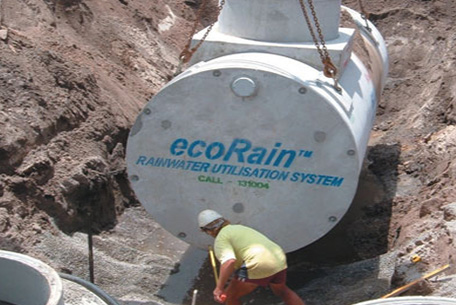
Description:
This product is yet to be launched.
Features:
Water is one of the most precious yet under-valued resources. Water shortages and the longer-term security of water supply for communities are serious concerns for South Africa which is facing problems with regards supply and massive cost increases of potable water.
ROCLA SA, in conjunction with ROCLA AUS and AllTrap Engineering SA, is offering the systems that have been tried and tested for many years now, in the driest inhabited continent on earth, Australia. Rocla SA will manufacture, market and distribute these systems to the South African market. Alltrap Engineering are the licensed distributors in South Africa for the ecoTechnic range of products from Austria which consists of the accessories that couple with the concrete tanks to make a complete rainwater harvesting system.
The Rocla ecoRain® product range is a complete rainwater utilization system. As such the ecoRain® system is designed to capture clean rainwater and store it underground for further use. As the source and quality of any captured water cannot be assured, the intention of the ecoRain® system design is to deliver stored rainwater for non-potable applications. The ecoRain® system consists of concrete, electrical and plumbing components designed to store, filter and deliver water from an underground concrete storage tank, via a pump, to non-potable purpose outlets and appliances. The ecoStorm® is an affordable stormwater filtration system designed to remove both solids and dissolved sediments, heavy metals and nutrients from surface water runoff.
Advantages of concrete rainwater harvesting tanks :
Rocla tanks are hidden below ground, are strong and durable, with an almost indefinite life span, and they help to improve water quality :
- Out of sight – Underground tank does not take up valuable land.
- Load bearing tank – The load-bearing capacity of the concrete tank allows it to be located almost anywhere on site.
- Continuous filtration – Self-cleaning filter and skimmer lower contaminant build-up.
- Highly efficient – Collects up to 95% of annual rainwater run-off.
- Low maintenance – Self-cleaning filter requires maintenance only twice a year.
- Sustainable – Extends the capability of existing water supply systems to keep pace with population growth.
- Harvested water used for toilets and irrigation.
- Bushfire protection – Can provide fire fighters with access to valuable water resources.
- Improved water quality – Underground concrete tanks are an ideal method of storing water, providing an almost germ-free environment away from light and warmth. The best storage tank material is concrete because concrete cisterns are strong, durable, last indefinitely and also neutralise naturally acidic rainwater.
- Range of sizes – Three standard tank sizes (3000, 5000 and 10,000 litres). With the modular nature of our commercial / industrial options, the target volumes of 1,000,000L and more are easily achieved.
Who should be harvesting water :
- The home-owner looking to save money on water consumption,
- Construction contractors and Contractors already in the business of installing (plastic) rainwater harvesting systems
- Developers, Architects and Engineers,
- Commercial end users such as : Factories and Warehouses, Shopping centres, Car wash outlets, Golf courses and Sports Ovals / Stadiums, Schools, Council parks,
Municipalities (water captured from the storm-water system could be used for fire-engines, irrigation, street cleaning, etc)
Background:
For many years residents in urban areas of Australia have enjoyed cheap, high quality water from authority-owned pipe networks. But as climate and rainfall patterns have changed and populations expanded, dam levels have decreased and raw water quality has deteriorated. Authorities implemented action plans, investing billions of dollars into the construction of alternative water supply systems (e.g. desalination plants). These action plans have inevitably increased the cost of potable water to the consumer. There has been a major shift towards water sustainable cities and Integrated Watercycle Management (IWM), implementing the rainwater capture and reuse aspects of Water Sensitive Urban Design (WSUD) to conserve potable supply.
Many authorities and research organisations in Australia have identified that by using rainwater tanks for non-potable applications, they can delay the need for expensive systems such as desalination and recycled wastewater. Multiple levels of government have encouraged support for tanks by offering grants, and changing legislation and building codes to require the installation of rainwater tanks for toilet flushing, irrigation and laundry uses. This could represent around 50% of typical domestic water usage. It is now almost commonplace across Australia for new domestic or commercial developments to include rainwater storage for non-potable reuse. Some authorities have taken this initiative even further by mandating a 25% water usage reduction by industry and commercial entities. In implementing larger scale harvesting and reuse systems, complying businesses will reap benefits long into the future.
Whether it is rainwater from the roof or storm-water from the catchment, water harvesting is integral to Water Sensitive Urban Design (WSUD) as it reduces the impact of pollution on water quality and stream flow, and helps developments meet water conservation objectives. Within the WSUD framework there are some clear objectives for the development of effective rainwater/ storm-water harvesting systems :
- Reconnect communities to the natural water cycle through innovative urban design.
- Reduce potable water consumption by employing water efficient appliances and reusing grey/rainwater.
- Minimise wastewater and treat it to a standard that is suitable for reuse or release to waterways.
- Capture and treat urban storm-water for reuse or release to waterways during construction and operational stages of urban developments.
- Preserve the natural hydrologic regime of catchments.

